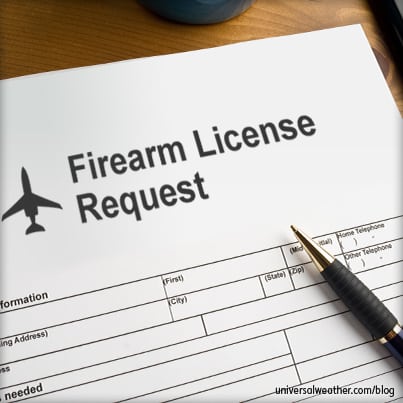Bringing Hunting Weapons Onboard a Business Aircraft – What You Should Know

There are many options available in terms of transporting hunting and personal protection weapons onboard your business aircraft; however, there are operating challenges to consider. Traveling with weapons will limit your choice of destination and tech stops and, in almost every case, will require additional pre-trip planning measures. It’s important to work with your 3rd-party provider to confirm all applicable restrictions and documentation requirements.
Here’s an overview of what you should know:
1. Regulations differ country to country
Your legal ability to carry weapons onboard differs depending on the country and purpose of the flight, but, in almost all cases, it’s more difficult to obtain permits for hand guns. Personal protection weapons are much more tightly controlled than others, and, in certain circumstances, permits may necessitate some level of diplomatic assistance. Appropriate hunting permits from the country you are planning to hunt in are necessary, as well as proof of ownership, gun licenses and registrations, as applicable. In some cases, it’s best to process firearm permits by way of a hunting contact at your destination, rather than through the assistance of a 3rd-party provider. Best practice is to supply hunting contact details to your 3rd-party provider and local ground handlers so that all parties can coordinate the permit process.
2. Consider tech stops when traveling with weapons onboard
You’ll need to research and plan tech stops carefully when traveling with weapons. For example, when flying to southern Africa, you’ll want to avoid tech stops in Nigeria, as hazardous material permits will be required if there are guns onboard. Permission to transport hazardous materials can be extremely difficult to obtain. Similarly, if you’re doing an overnight stop in the UK, weapons may need to be stored by a licensed firearms dealer or airport police, which requires advance coordination.
When planning hunting trips, work with your 3rd-party provider to select the best tech stops for your flight. There are also security companies available to help with that research.
3. Certain countries are particularly strict on weapons
Here are more examples of some countries with restrictions in place:
- Barbados: You’ll need two weeks’ advance notice to arrange permission to transport weapons on a tech stop.
- Trinidad: Even for a tech stop, you’ll need to convince local police that onboard weapons are not hazardous material.
- Poland: You’ll have to have a European Union firearms permit.
- Senegal: Provide at least one week’s advance notice to arrange permission for guns onboard.
- India: This country is particularly strict on bringing weapons into the country and requires that the weapons cases be “sealed.” Authorities will witness sealing of weapons cases prior to stamping your general declaration and allowing you into the country.
- Mexico: This country is also strict in terms of bringing guns into the country and requires specific information in advance.
In addition to the above examples, many countries restrict the quantity of ammunition you may carry onboard.
4. Provide required information and documentation in advance
Here are some examples of documentation requirements:
- Canada: If you’re a visitor to Canada and do not have a Canadian firearms license and registration certificate, you’re required to declare all firearms in writing, which can be done by filling out Form CAFC 909 (non-resident firearm declaration) and paying a 25CDN fee. This has the same effect as a temporary license and registration and is valid for up to 60 days. If you’re importing restricted firearms, you’ll need an authorization to transport. The application can be obtained from Canada Firearms Centre at 1-800-731-4000. Visitors cannot, under any circumstances, import prohibited firearms.
- Europe: Most European countries require information in advance, such as serial numbers, make, model and owner details.
- South Africa: Specific documentation is required, as well as disclosure of the amount of ammo you’re bringing in. Also, you may not take more ammo out than you bring in.
5. Diplomatic and military flights have different considerations
Diplomatic flights with weapons onboard must usually obtain permissions from the appropriate embassies through diplomatic channels for all international stops. Military flights with onboard weapons will, in most cases, need to coordinate approvals through diplomatic channels.
6. Know penalties for not reporting onboard weapons
It’s important to follow proper procedures and notification requirements when traveling with weapons. If undeclared weapons are discovered onboard, it may lead to confiscation of weapons, fines, denial of entry into the country and imprisonment. Ultimately, the responsibility falls on the captain to ensure that correct procedures and processes have been followed. For that reason, it’s recommended that the captain confirm permit and procedural requirements, in advance, for each intended international destination and tech stop.
7. You may be restricted in terms of game and hunting trophies transported aboard your aircraft
Always check with Customs, Immigration and Quarantine in your home country as to what is and is not permissible to carry onboard. You may have issues and challenges to deal with when transporting unique items, such as rare animals or more exotic bear species from northern Canada and Russia, back to your home country.
8. Avoid complications
To avoid complications when traveling with weapons, it’s best to give yourself plenty of lead time to work with your 3rd-party provider and local ground handlers. Always confirm the latest regulations, restrictions and notification requirements concerning transport of weapons. Some locations require more than two weeks’ lead time to arrange permission to have weapons onboard, and certain tech stop options will not be practical. Also, keep in mind that some countries require that you declare any weapons prior to leaving the country.
Conclusion
Be prepared for operational challenges and assorted restrictions when traveling with weapons. Always declare any weapons onboard and be aware that traveling with such items will often restrict operational flexibility in terms of both tech and destination stops.
Questions?
If you have any questions about this article, contact me at abelperez@univ-wea.com.



